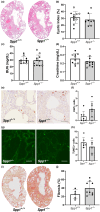Osteopontin deletion attenuates cyst growth but exacerbates fibrosis in mice with cystic kidney disease
- PMID: 39238069
- PMCID: PMC11377176
- DOI: 10.14814/phy2.70038
Osteopontin deletion attenuates cyst growth but exacerbates fibrosis in mice with cystic kidney disease
Abstract
Osteopontin (OPN) is a multi-functional glycoprotein that coordinates the innate immune response, prevents nanocrystal formation in renal tubule fluid, and is a biomarker for kidney injury. OPN expression is markedly increased in cystic epithelial cells of polycystic kidney disease (PKD) kidneys; however, its role in PKD progression remains unclear. We investigated the in vitro effects of recombinant OPN on the proliferation of tubular epithelial cells from PKD and normal human kidneys and in vivo effects of OPN deletion on kidney cyst formation, fibrosis, and mineral metabolism in pcy/pcy mice, a non-orthologous model of autosomal-dominant PKD. In vitro studies revealed that OPN enhanced the proliferation of PKD cells but had no effect on normal kidney cells. Deletion of OPN in pcy/pcy mice significantly reduced kidney cyst burden; however, this was accompanied by increased fibrosis and no change in kidney function. The loss of OPN had no effect on kidney macrophage numbers, cyst epithelial cell proliferation, or apoptosis. Furthermore, there was no difference in kidney mineral deposition or mineral metabolism parameters between pcy/pcy mice with and without OPN expression. Global deletion of OPN reduced kidney cyst burden, while paradoxically exacerbating kidney fibrosis in mice with cystic kidney disease.
Keywords: Osteopontin; PKD; fibrosis; matricellular proteins; mineral metabolism.
© 2024 The Author(s). Physiological Reports published by Wiley Periodicals LLC on behalf of The Physiological Society and the American Physiological Society.
Conflict of interest statement
DPW has received research funding from Synkine Therapeutics. All other authors have nothing to disclose.
Figures






Similar articles
-
Inactivation of Invs/Nphp2 in renal epithelial cells drives infantile nephronophthisis like phenotypes in mouse.Elife. 2023 Mar 15;12:e82395. doi: 10.7554/eLife.82395. Elife. 2023. PMID: 36920028 Free PMC article.
-
Pkd2 Deficiency in Embryonic Aqp2 + Progenitor Cells Is Sufficient to Cause Severe Polycystic Kidney Disease.J Am Soc Nephrol. 2024 Apr 1;35(4):398-409. doi: 10.1681/ASN.0000000000000309. Epub 2024 Jan 23. J Am Soc Nephrol. 2024. PMID: 38254271 Free PMC article.
-
Dietary phosphate restriction attenuates polycystic kidney disease in mice.Am J Physiol Renal Physiol. 2020 Jan 1;318(1):F35-F42. doi: 10.1152/ajprenal.00282.2019. Epub 2019 Nov 4. Am J Physiol Renal Physiol. 2020. PMID: 31682174 Free PMC article.
-
Inhaled mannitol for cystic fibrosis.Cochrane Database Syst Rev. 2015 Oct 9;(10):CD008649. doi: 10.1002/14651858.CD008649.pub2. Cochrane Database Syst Rev. 2015. Update in: Cochrane Database Syst Rev. 2018 Feb 09;2:CD008649. doi: 10.1002/14651858.CD008649.pub3. PMID: 26451533 Updated.
-
Intravenous antibiotics for pulmonary exacerbations in people with cystic fibrosis.Cochrane Database Syst Rev. 2025 Jan 20;1(1):CD009730. doi: 10.1002/14651858.CD009730.pub3. Cochrane Database Syst Rev. 2025. PMID: 39831540
Cited by
-
Microvascular aberrations found in human polycystic kidneys are an early feature in a Pkd1 mutant mouse model.Dis Model Mech. 2025 Apr 1;18(4):dmm052024. doi: 10.1242/dmm.052024. Epub 2025 Apr 28. Dis Model Mech. 2025. PMID: 40114603 Free PMC article.
References
-
- Anders, H. J. , Suarez‐Alvarez, B. , Grigorescu, M. , Foresto‐Neto, O. , Steiger, S. , Desai, J. , Marschner, J. A. , Honarpisheh, M. , Shi, C. , Jordan, J. , Muller, L. , Burzlaff, N. , Bauerle, T. , & Mulay, S. R. (2018). The macrophage phenotype and inflammasome component NLRP3 contributes to nephrocalcinosis‐related chronic kidney disease independent from IL‐1‐mediated tissue injury. Kidney International, 93, 656–669. - PubMed
-
- Cowley, B. D., Jr. , Ricardo, S. D. , Nagao, S. , & Diamond, J. R. (2001). Increased renal expression of monocyte chemoattractant protein‐1 and osteopontin in ADPKD in rats. Kidney International, 60, 2087–2096. - PubMed
-
- Cui, R. , Takahashi, F. , Ohashi, R. , Gu, T. , Yoshioka, M. , Nishio, K. , Ohe, Y. , Tominaga, S. , Takagi, Y. , Sasaki, S. , Fukuchi, Y. , & Takahashi, K. (2007). Abrogation of the interaction between osteopontin and alphavbeta3 integrin reduces tumor growth of human lung cancer cells in mice. Lung Cancer, 57, 302–310. - PubMed
MeSH terms
Substances
Grants and funding
- R01DK122212/HHS | NIH | NIDDK | Division of Diabetes, Endocrinology, and Metabolic Diseases (DEM)
- R01 DK129255/DK/NIDDK NIH HHS/United States
- K01 DK119375/DK/NIDDK NIH HHS/United States
- R01DK129255/HHS | NIH | National Institute of Diabetes and Digestive and Kidney Diseases (NIDDK)
- R01 DK122212/DK/NIDDK NIH HHS/United States
LinkOut - more resources
Full Text Sources
Medical
Molecular Biology Databases
Research Materials
Miscellaneous

